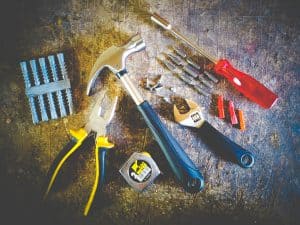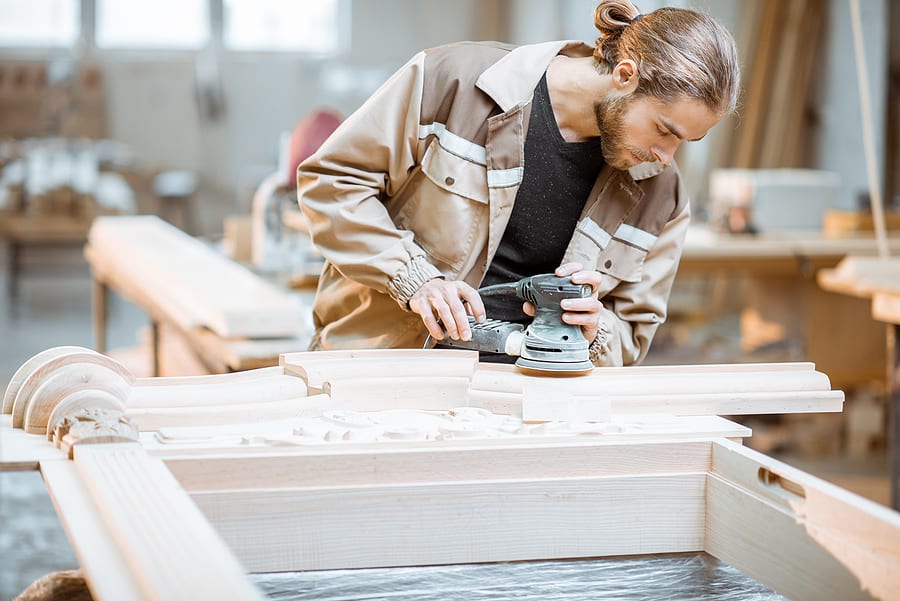Spring is finally here and the best way to welcome it is to start getting busy with some spring woodworking projects. There are plenty of DIY projects you can do ranging from simple stuff like hanging shelves and benches to more complicated ones like a man cave or she shed. It doesn’t matter if you’re new to the woodworking and carpentry. As long as you have the drive to learn and the right tools to use, you should be fine.

Bird House
Bird houses provide birds with a place to nest. Aside from helping the bird with these nesting boxes, you’re garden also benefits from their presence. Birds help control pests and weeds while also allowing cross pollination. Plus, it’s always nice to see and hear birds on your property.
A bird house is a relatively easy woodworking project. In fact, you can finish this modern style bird house from Family Handyman in just a couple of hours. You only need a few pieces of board and plywood, some screws or nails, a dowel rod, and paint. As for your woodworking tools, you will need a miter saw, table saw, hole saw, drill, dado blades, and clamps.
This woodworking project is simple enough to be done with a hand saw. A miter saw, however, will finish the sawing tasks in no time. If you have the means, invest on a Hitachi C10FCH2 15-Amp 10-Inch Compound Miter Saw or something similar. Woodworkers and carpenters will love the laser marker feature of this Hitachi miter saw. Its 15 amp motor ensures you can cut through some of the toughest materials. It’s also the lightest in its class at only 26.5 pounds making it easier to carry and maneuver.
The hole saw or hole cutter is necessary for making the entrance of the bird house. The Blu-Mol Xtreme Bi-Metal 13pc Journeyman’s Hole Saw Kit is a good investment to have if you decide to make a buck out of woodworking by creating different projects that sell.

Raised Wooden Planters
Most herbs and vegetables grow best around spring. Make the most of the season by giving your garden a head start. You must prepare the soil 2 to 3 weeks prior to planting. This should give you more than enough time to build elevated wooden planters if you have limited space in your garden.
To build a raised planter, you basically need wood and tools. For your wood, you can use rot-resistant cedar or redwood. If you prefer something cheaper, use wooden pallets. Just make sure you get the ones that have not been treated with chemicals.

The main tools you will need are a saw, hammer, drill and drill bits, and measuring tools. You can do a better job with this DIY project if you have a sander, clamps, level, and wood glue. You can also coat it with paint if you want fancier planters.
Basically, you need to measure and cut the wood. The measurements will depend on the area where you’ll be setting up your planters and how high you want them to be. A 2 x 4 feet planter seems ideal. You’ll need 4 feet wooden planks for the box bottom and the front and back sides. Lay the pieces of wood down side by side on the ground or work surface. See how many planks it takes to reach a width of about 2 feet. Measure the width and use this as guide for the planter’s other two sides.
You need braces for the planks to make your planters sturdier. If you want them to be as high as your waist so you don’t have to stoop, you can extend the corner braces so they’ll act as legs.
For cutting the wood, a hand saw will do but it requires a lot more time and effort. Invest on power saws like a circular saw for faster and more accurate cuts. The Skil 5480-01 120-Volt Corded 7-1/4″ Circular Saw is equipped with a 6.5 amp motor capable of up to 5,300 RPMs of power. The foot is 20% larger than its predecessors allowing you better stability so you can do your DIY projects with ease.
Once done with all the sawing, all you need now is to screw and nail everything together. Afterwards, place food-grade plastic liner along the sides before filling your planter with soil. Check out the link above and the video below to get a better grasp on how to build raised wooden planters.
Tool Shed
Since you’ll be busy with your garden, you need a place to tools and garden supplies. A tool shed is a simple enough for noobs who want to challenge themselves. In fact, you can finish this woodworking project in a day or two depending on your skill.
The tool shed design by This Old House should be a good DIY project to do this spring. You can also check out this list of tool shed designs for more ideas. It includes more complicated ones if you’re feeling good about your woodworking skills.
You’ll find the required measurements for your wood including the ones for the frame, walls, roof, doors and shelves. Since this project requires lots of wood, you will need clamps and some wood glue. Screws will help keep the structure together but using wood glue would help reinforce it.
Gorilla Glue is considered one of the best wood glue brands. It’s perfect for your tool shed since it boasts of having ANSI/HPVA Type II water resistance. Plus, it dries real fast. It’s good to go after 20 to 30 minutes with a clamp and it takes only 24 hours to be fully cured.
The clamps will ensure the parts are held together tightly as you screw or glue them together. You’ll need bar like the Craftsman 12 inch Bar Clamp and corner clamps such as Serendipper’s Woodworking Corner Clamp Tools in your basic woodworking tool kit. As you take the craft seriously, you should invest on other kinds such as G clamps, hand screw clamps, and spring clamps.

Chicken Coop
These days, it’s even more important to be self-sustainable. With so many horrific things happening around the world, it’s kinda scary to go out. Well, you shouldn’t really go out that much right now because of the coronavirus pandemic.
To help lessen the chances of exposure, you can grow or raise your own food at home. Those into homesteading have been growing crops and vegetables while also raising animals for meat. It’s about time you do the same.

If you want a steady supply of eggs and poultry, you can raise chickens in your backyard. All you need basically are a chicken coop, feeds and the chickens, of course. That said, chicken coops are useful woodworking projects you can do this spring.
You can purchase pre-made chicken coops or you can make your own if you prefer giving it a little personal touch. Morning Chores has gathered a few chicken coop plans you can get ideas from. Before sawing and hammering away, there are a few things you need to consider first.
Figure out how many chickens you want to raise. Each one requires 3 to 4 square feet of space. If you want 3 chickens, you need at least a 3 x 4 feet chicken coop. It’ll be better for your chickens if you can afford a larger coop.
Make sure you place the coop in the right place. It needs to have proper ventilation and enough sun. Also, find a spot where the noise and smell will not bother anyone else.

The chicken coop should have a feeder and waterer, windows for ventilation, proper lighting for warmth and better egg production, and a nesting box for the hens to lay eggs. You can also add a perch area, dust bath box. Also, place a poop board underneath to catch the poop and make it easier to clean up.
If you have a large enough area, you should consider putting up a chicken run. This is an enclosed area where the birds can run around. Make sure the wire mesh is properly secured to prevent your chickens from getting out and predator from getting in.
Building a chicken run without a wire cutter is near impossible. Use something like the Channellock 526 Slip Joint Plier to make your job easier. The slip joint plier also works as a wire cutting shear. It is made of high carbon c1080 steel with an electronic coating so durability and rust are not issues.
Treehouse
If you’re up to the challenge, why don’t you try spring woodworking projects on a grander scale. A treehouse, for example, is something you and the kids can do together. Just imagine the beautiful memories your family will be making with your very own treehouse.
You need a tree for obvious reasons. Find a sturdy and deep-rooted one for this slightly complex woodworking project. A tree with two or three trunks is preferred since it will offer more support to your treehouse. Speaking of support, you should do diligent research on how to ensure your treehouse is safe.
As for the treehouse design, it’s all up to you. You can ask your children to draw the treehouse they like but make sure to guide them so they don’t make something too ridiculous or difficult. It can be something simple like the one from Popular Mechanics. Well, the design looks simple since the treehouse is mainly just a floor and hand rails with a ladder to boot. However, the mechanics behind keeping the treehouse together is slightly complicated. If you really want to challenge your woodworking and carpentry skills, consider a treehouse design like the one below.
Regardless of the design, you have to use high quality lumber, especially for your beams and floor. You need them to be sturdy enough to carry the whole gang. As you can imagine, you have to secure each part properly. That goes double for the pieces of wood that will directly attach the treehouse to the tree.
You will need the right kind of screw for this spring woodworking project. Use galvanized lag bolts, structural or constructions screws and wood deck screws. To further strengthen your support, use joist hangers, Garnier limbs, and rafter ties.
A cordless drill will help ensure the screws are, well, screwed in tightly. The DeWalt 20V MAX Lithium Ion Compact Drill/Driver Kit is compact, lightweight and battery-operated allowing you to work on your treehouse with ease. You could use a backup battery so you can continue with your spring woodworking projects even if the first one runs out of juice. Other tools and materials you’ll need are a jigsaw, hammer, nails, level, tape measure, and clamps among other things.
Use your jigsaw to make curved cuts on the platform that will circle the tree trunks. Keep the cut as close to the tree as possible. If you make the hole too large, someone’s foot might get caught or fall through. The DeWalt DW317K 5.5 Amp Corded Jig Saw Kit will help you get that perfect cut.
You may also want to use a sander to smoothen the wood and avoid scratches and splinters. Get yourself something like the Black+Decker Mouse Detail Sander. It utilizes a 1.5A motor capable of 1,400 orbits per minute. The compact sander is designed to reach tight spaces. However, the Black+Decker Mouse is corded so you should do the sanding in your work area before attaching the pieces up on the tree.

Start your spring woodworking projects early so you can finish as many as you wish. Take advantage of the longer hours and nice weather by finally accomplishing some of the DIY projects you have been aching to do. It’s also the perfect time to start some homesteading projects to prepare you for the seasons after spring. Get to know more woodworking and homesteading projects at Gentleman Pirate Club.
























